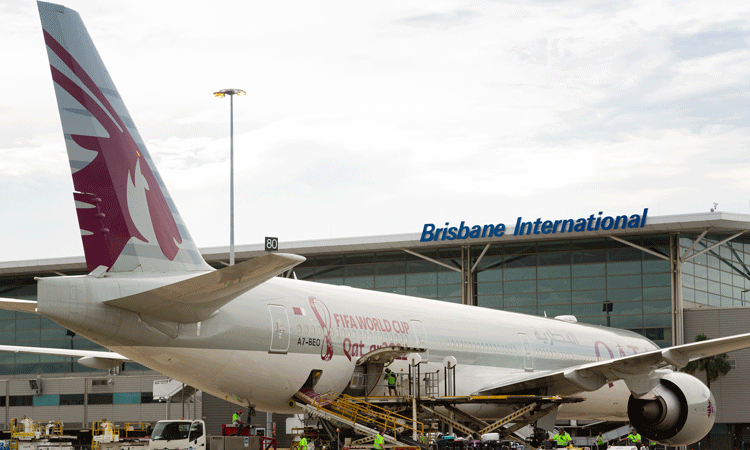Restoring connectivity to Queensland, Australia: a Q&A with Anthony Cicuttini
- Like
- Digg
- Del
- Tumblr
- VKontakte
- Buffer
- Love This
- Odnoklassniki
- Meneame
- Blogger
- Amazon
- Yahoo Mail
- Gmail
- AOL
- Newsvine
- HackerNews
- Evernote
- MySpace
- Mail.ru
- Viadeo
- Line
- Comments
- Yummly
- SMS
- Viber
- Telegram
- Subscribe
- Skype
- Facebook Messenger
- Kakao
- LiveJournal
- Yammer
- Edgar
- Fintel
- Mix
- Instapaper
- Copy Link
Posted: 2 February 2024 | Anthony Cicuttini | No comments yet
Anthony Cicuttini, Senior Vice President (SVP) and head of Aviation Development at Brisbane Airport Corporation spoke to International Airport Review about maintaining airline connections and attracting new passenger volumes.


c: BNE
China Eastern Airlines resumed its non-stop service between Shanghai and Brisbane from October 2023. What does the Chinese market mean to the Queensland economy?
China was Queensland’s most lucrative source market pre-pandemic, so securing that capacity back is a win for the state, and Brisbane of course. It’s been a top priority for the wider industry, so we’re really glad to welcome back China Eastern. China Southern also started services again in the middle of November 2023. So, the northern winter season’s looking very strong.
What kind of traveller are you looking to attract, and is there anything that you’re doing to ease this process?
I think the diversity of the Brisbane and Southeast Queensland economy is so broad that we focus on increasing our depth and breadth of the network across multiple carriers. So, there’s not really one particular demographic or sort of visitor type that we’re looking for. There really is something for everyone in the region.
What challenges are you facing at the moment?
I don’t think we’re alone in feeling the constraints of airline resources, both in labour and in fleet. There are some solid opportunities available, but at times there just aren’t enough flight crew or aircraft available to fly them. We’re just working with our airline partners to see when we can get services restored.
What are your ambitions? Where are you currently underserved?
I think our ambitions are to work with our existing network and our existing airline partners to reinforce frequencies or get services back that haven’t been restored yet. Certainly, in terms of markets, North America, of course we’re getting seasonal capacity coming in on this winter season from United to San Francisco as well as LAX and Air Canada upgrading aircraft as well.
North America is one of our areas that we’re looking at. New Zealand and Asia as well. I think looking beyond the immediate network though, the additional breadth in the Chinese markets is a priority for us. Also, looking a bit more medium to longer term, is the Indian market as well.


c: BNE
What do you consider when looking to open a new route? What are the top three questions that must be answered?
A new route fundamentally must solve a problem. So, it’s about understanding where those problems are and what a new route can backfill. Questions we consider are how are passengers travelling there at present? Is there sufficient volume in place of demand that can sustain services? Are there high fares on the route that a new entrant can maybe counter and provide some price stimulation?
Do we think we have the network that an airline can backfill? And then secondly, is there an airline that’s commercially or operationally ready to come onto the route as well? The demand could be doing one thing, but we also need to have an airline that’s ready to come onto the route.
Once an airline is onboard, how do you make sure that you keep them as a customer?
I think, fundamentally, it’s communication and transparency that really drives a lot of how we treat our airline customers. It’s just understanding how the route’s performing, where we can add value as an airport and how we can facilitate discussions across the industry stakeholders as well.
What are your three most exciting developments happening at your airport?
The three big ones for us are the renovation of our domestic and international terminal. The renovations are focused on the introduction of new Commonwealth security standards and we’re taking advantage of the need to design; to start integrating larger security machines; to re-look at our passenger flows and optimise that to reduce operating and capital expenditure, as well over the long term.
Number three of course is in the very early stages of our Terminal 3 planning. We currently have two terminals and Terminal 3 will be available before the Olympic Games. So, it’s a potentially new hybrid terminal, and we’re currently talking to our airline partners as to what that will look like.
Brisbane has a domestic terminal and an international terminal, but we’re looking to combine some of those flows under one roof in what we call a hybrid terminal. This is currently not a very common set up, as typically the domestic and international inhabit separate buildings.
Can you give us your 30-second pitch on why an airline should choose to fly to your airport rather than any of your competitors?
Brisbane, and larger Southeast Queensland, is an iconic destination and is really going from strength to strength. The economy is well diversified across multiple sectors. We have a large mining contingent, services, and tourism as well. Our demographics are mixed and supports healthy VFR (visiting friends and family) flows. And Brisbane, of course, is set to join the list of Olympic host cities since we are going to be hosting the Olympic and Paralympic Games in 2032. This, I think, emphasises the point that I made earlier that Brisbane and Queensland is just going from strength to strength.
The next point really is we have the largest domestic network in Australia, meaning our airline partners can seamlessly connect their passengers to other markets, which supports stronger yields and loads.


Originally from Canada, Anthony relocated to Australia permanently in 2011 having worked overseas prior in Dubai and Malaysia to support terminal developments and airport planning projects. He holds an Advanced Diploma and a master’s degree in aviation management from Georgian College and Griffith University respectively. Through his consulting roles, he has completed projects in over in 20 countries.
Related topics
Related airports
Related organisations
Brisbane Airport Corporation, Brisbane Airport Corporation (BAC)


















